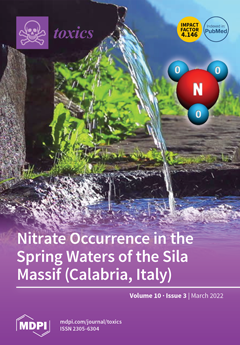Background: Occupational health hazards associated with phthalate exposure among nurses are still not well understood. Methods: We used high-performance liquid chromatography and tandem mass spectrometry to analyze phthalates. Anthropometric measurements and questionnaires were conducted. Results: We observed associations between mono-benzyl phthalate (MBzP) and body mass index (BMI), hip circumference (HC), waist circumference (WC), waist to height ratio (WHtR), and fat mass index (FMI), visceral fat content, BMI risk and hip index risk (HIrisk), adjusted to consumer behavior and consumer practices (r = 0.36–0.61;
p ≤ 0.046). In the same model, we detected an association between mono-n-butyl phthalate (MnBP) and waist to hip ratio (WHR; r = 0.36;
p = 0.046), mono-carboxy-isononyl phthalate (cx-MiNP) and BMI (r = 0.37;
p = 0.043), HC (r = 0.4;
p = 0.026) and WHtR (r = 0.38;
p = 0.037), between mono-oxo-isononyl phthalate oxo (MiNP) and HC (r = 0.36;
p = 0.045), mono-2-ethylhexyl phthalate (MEHP), mono(2-ethyl-5-oxohexyl) phthalate (oxo-MEHP) and HIrisk (r = 0.38–0.41;
p ≤ 0.036), between oxo-MEHP and Anthropometric Risk Index (ARI risk; r = 0.4;
p = 0.028). We detected a relationship between BMI and MBzP (β = 0.655;
p < 0.001) and mono-2-ethylhexyl phthalate (MEHP; β = −0.365;
p = 0.003), between hip circumference and MBzP (β = 0.486;
p < 0.001), MEHP (β = −0.402;
p = 0.001), and sum of secondary metabolites of diisononyl phthalate (∑DiNP; β = 0.307;
p = 0.016). We observed a relationship between fat content and MBzP (β = 0.302;
p = 0.033), OH-MnBP (β = −0.736;
p = 0.006) and MiBP (β = 0.547;
p = 0.046), visceral fat content and MBzP (β = 0.307;
p = 0.030), HI-risk and MBzP (β = 0.444;
p = 0.001), ARI-risk and sum of di-n-butyl phthalate metabolites (∑DnBP; β = 0.337;
p = 0.018). We observed an association between the use of protective equipment with cx-MiNP. Conclusions: Occupational exposure to phthalates may induce abdominal obesity and result in obesity-related metabolic disorders.
Full article






